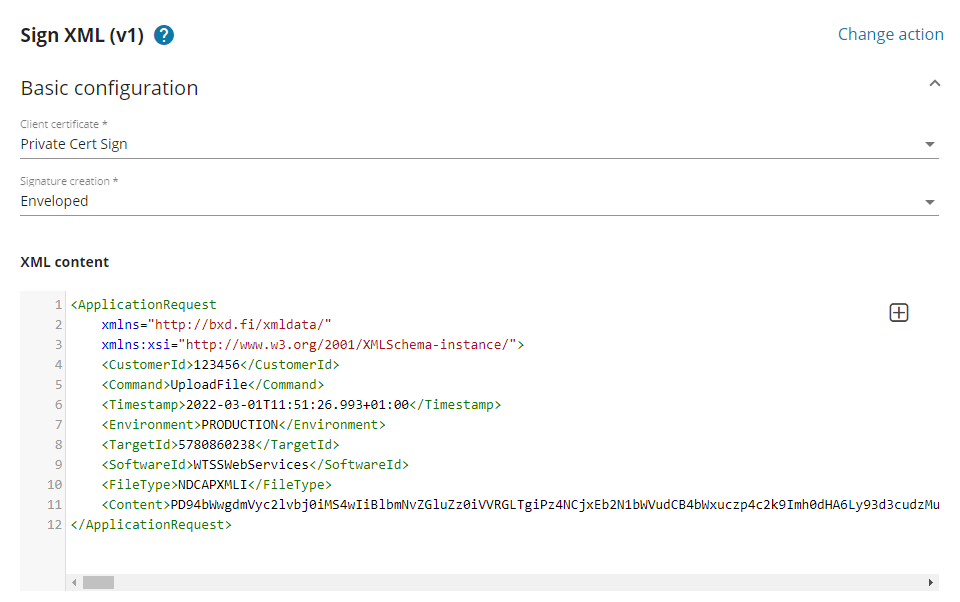XML Sign
Description
The XML Sign action applies an XML signature to XML formatted data.
Usage

This action creates an XML Signature that guarantees both the integrity and authenticity of the message. This allows to verify that data was not altered after it was signed with a digital certificate. The syntax of the XML signature follows the standard provided by the W3C.
- Select an available digital certificate you want to use
- Choose one of the available signature structures (enveloped, enveloping or detached)
- Insert the XML formatted message you want to sign (you can also insert data referring to a previous step by clicking the add [+] button)
NOTE The available certificates present in the Client certificate drop down menu are stored in the Certificates section of Extension Kit. For more information, please see our documentation
Detached Signature Elements
In the case you have selected the Detached signature creation structure, you will be also prompted to select which element or elements to sign.
It is also possible to sign using the Web Service Security OASIS Standard by selecting the matching option. For more information regarding this standard please check the official documentation.

NOTE: You can separate the various elements to sign using a semicolon
;
Enveloped Signature Output Sample
Description: The signature is inside the XML data that is signing
<?xml version="1.0" encoding="UTF-8"?>
<Document xmlns:xsi="http://www.w3.org/2001/XMLSchema-instance" xmlns="urn:iso:std:iso:20022:tech:xsd:pain.001.001.03">
<CstmrCdtTrfInitn>
<GrpHdr>
<MsgId>ERPxAP3C</MsgId>
<CreDtTm>2022-01-19T06:55:00</CreDtTm>
<NbOfTxs>4</NbOfTxs>
<CtrlSum>4433.00</CtrlSum>
<InitgPty>
<Nm>Dutch office supplies, office furniture and coffee machines trading co</Nm>
<Id>
<OrgId>
<Othr>
<Id>KVK9937465</Id>
</Othr>
</OrgId>
</Id>
</InitgPty>
</GrpHdr>
</CstmrCdtTrfInitn>
<Signature xmlns="http://www.w3.org/2000/09/xmldsig#">
<SignedInfo>
<CanonicalizationMethod Algorithm="http://www.w3.org/TR/2001/REC-xml-c14n-20010315" />
<SignatureMethod Algorithm="http://www.w3.org/2001/04/xmldsig-more#rsa-sha256" />
<Reference URI="">
<Transforms>
<Transform Algorithm="http://www.w3.org/2000/09/xmldsig#enveloped-signature" />
<Transform Algorithm="http://www.w3.org/TR/2001/REC-xml-c14n-20010315" />
</Transforms>
<DigestMethod Algorithm="http://www.w3.org/2001/04/xmlenc#sha256" />
<DigestValue>kEWCFOFB9GKq8x61Q9YR+v0WDBXO0CKcxseOjag7rSA=</DigestValue>
</Reference>
</SignedInfo>
<SignatureValue>bqDDD9ObByZWWQODuciNlg+T6zsW0RxTeiTxRu5g0ZRKzIwqYTjGM11wenNTblinZqa6t++bQ8=</SignatureValue>
<KeyInfo>
<X509Data>
<X509Certificate>MIIC+zCCAeOgAwIBAgIDASxVMA0GCSqGSIb3DQEBBQUAMGQxCzAJo1NzKBgQCClm8tj/+</X509Certificate>
</X509Data>
</KeyInfo>
</Signature>
</Document>
The length of SignatureValue and X509Certificate data has been reduced to simplify this example
Enveloping Signature Output Sample
Description: The signed XML data is contained within an Object element within the Signature element.
<Signature xmlns="http://www.w3.org/2000/09/xmldsig#">
<SignedInfo>
<CanonicalizationMethod Algorithm="http://www.w3.org/TR/2001/REC-xml-c14n-20010315" />
<SignatureMethod Algorithm="http://www.w3.org/2001/04/xmldsig-more#rsa-sha256" />
<Reference URI="#doc">
<DigestMethod Algorithm="http://www.w3.org/2001/04/xmlenc#sha256" />
<DigestValue>U9UAQbjZfDVEEe67zrfJ3a5XB0XxVd5XhRgs2+ffurw=</DigestValue>
</Reference>
</SignedInfo>
<SignatureValue>xkJhP6TJ9ZwJHxLLR9j4FwVVX8ITiv2xfuP4VcG6VU+CUM3QTM+cJQ==</SignatureValue>
<Object Id="doc">
<ApplicationRequest xmlns="http://bxd.fi/xmldata/" xmlns:xsi="http://www.w3.org/2001/XMLSchema-instance/">
<CustomerId>123456</CustomerId>
<Command>UploadFile</Command>
<Timestamp>2022-03-01T11:51:26.993+01:00</Timestamp>
<Environment>PRODUCTION</Environment>
<TargetId>5780860238</TargetId>
<SoftwareId>WTSSWebServices</SoftwareId>
<FileType>NDCAPXMLI</FileType>
<Content>PD94bWwgdmVyc2lvbj0iMS4wIiBCB4bWxuczp4c2k9Imh0dHA6Ly93d3cudzMub3JnnQ+</Content>
</ApplicationRequest>
</Object>
</Signature>
The length of SignatureValue and Content data has been reduced to simplify this example
Detached Signature Output Sample
Description: A detached signature is neither enveloping nor enveloped. It is a type of digital signature that is kept separate from its signed data, as a sibling element.
<?xml version="1.0" encoding="UTF-8"?>
<internally-detached>
<ds:Signature xmlns:ds="http://www.w3.org/2000/09/xmldsig#">
<ds:SignedInfo>
<ds:CanonicalizationMethod Algorithm="http://www.w3.org/TR/2001/REC-xml-c14n-20010315"/>
<ds:SignatureMethod Algorithm="http://www.w3.org/2000/09/xmldsig#rsa-sha1"/>
<ds:Reference URI="#data">
<ds:DigestMethod Algorithm="http://www.w3.org/2000/09/xmldsig#sha1"/>
<ds:DigestValue>MNMuc6DNjQ+icWWlRZGBn24qR7HIxn3Bs+CKQDI2au8=</ds:DigestValue>
</ds:Reference>
</ds:SignedInfo>
<ds:SignatureValue/>
</ds:Signature>
<document Id="data">
<title>title</title>
<author>writer</author>
<date>today</date>
<content>
<para>First paragraph</para>
<para>Second paragraph</para>
</content>
</document>
</internally-detached>